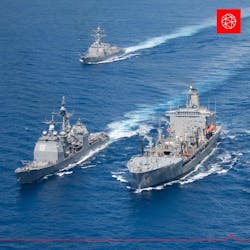Navy picks L3Harris to manufacture sensors and weapons tactical network equipment for anti-air warfare
WASHINGTON – U.S. Navy anti-air warfare experts needed an electronics manufacturer to build sensors and weapons tactical network equipment for Navy surface warships and carrier-based aircraft. They found their solution from L3Harris in Camden, N.J.
Officials of the Naval Sea Systems Command in Washington announced a $67.4 million order to L3Harris last month to build AN/USG-2B System, AN/USG-3B System, spares, signal data processors for the Navy Cooperative Engagement Capability (CEC) program.
The CEC is a tactical sensor and weapons network that uses Navy ships and aircraft for anti-air warfare. It combines information from sensors operating over wide geographic areas in a common tactical picture for battle groups at sea. It improves overall situational awareness, and enables fleet commanders to work closely together to attack enemy forces from long ranges.
This order includes stock point, equipment repairs, repair material, engineering studies and analyses, configuration, obsolescence, tech data management, and technical data package.
The AN/USG-3 is the airborne designation of CEC deployed in E-2C and E-2D carrier-based radar surveillance aircraft. Other CEC terminals are aboard Navy surface warships; U.S. Marine Corps command posts, aviation command-and-control centers, and surveillance aerostats.
The AN/USG-2 for Navy surface warships -- also known as the Cooperative Engagement Transmission Processing Set (CETPS) -- coordinates all task force anti-air warfare sensors into one real-time, fire-control-quality composite track picture by distributing sensor data from each cooperating unit to all other cooperating units via a real time line of sight fire control sensor and engagement data distribution network.
The AN/USG CETPS resists the effects of electronic jamming and provides accurate gridlocking between CEC cooperating units. Each cooperating unit independently combines all the distributed sensor data into a common track picture with high capacity, parallel processing and advanced algorithms. The resulting composite track picture is the same on all cooperating units.
The CETPS consists of cooperative sensing, engagement decision, engagement execution and data distribution, and enables all anti-air warfare sensors and weapons in a battle group to function as one distributed system.
The CETPS also enables several battle groups to conduct network-centric operations by sharing common picture and tactical capabilities.
The CETPS is composed of two primary system groups and five subsystem functions. The two primary system groups are the Data Distribution System (DDS) and Cooperative Engagement Processor (CEP). The five subsystem functions are the data distribution, command/display support, sensor cooperation, engagement decision, and engagement execution.
The CEC blends sensors and weapons into an integrated real-time network that expands the battlespace; enhances situational awareness; increases depth of fire; enables long intercept ranges; and improves decision and reaction times.
It extracts and distributes sensor information such that the superset of this data is available to all participating CEC-equipped units by fusing the distributed data from shipboard, airborne, composite tracking network ground-mobile units, Joint Land Attack Cruise Missile Defense Elevated Netted Sensor System (JLENS), and coalition partners into one fire-control-quality air track picture.
The system uses line-of-sight data distribution to share radar-measurement data among sensors and weapons to create one distributed integrated air picture. It combines surveillance and targeting information such that the combined system is greater than the sum of its parts.
The jam-resistant CEC obtains target track information to form one real-time composite track to help coordinate theater air and missile defense to engage incoming cruise missiles.
On this order L3Harris will do the work in Largo, Fla.; Salt Lake City; and Menlo Park, Calif., and should be finished by October 2025. For more information contact L3Harris Technologies online at www.l3harris.com, or Naval Sea Systems Command at www.navsea.navy.mil.
About the Author
John Keller
Editor-in-Chief
John Keller is the Editor-in-Chief, Military & Aerospace Electronics Magazine--provides extensive coverage and analysis of enabling electronics and optoelectronic technologies in military, space and commercial aviation applications. John has been a member of the Military & Aerospace Electronics staff since 1989 and chief editor since 1995.
